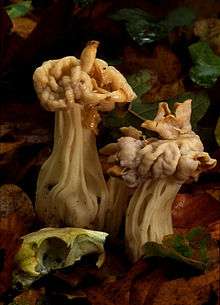Helvella crispa
Helvella crispa, also known as the white saddle, elfin saddle or common helvel, is an ascomycete fungus of the Helvellaceae family. The mushroom is readily identified by its irregularly shaped whitish cap, fluted stem, and fuzzy undersurfaces. It is found in eastern North America and in Europe, near deciduous trees in summer and autumn.
Etymology
The fungus was originally described as Phallus crispus by the naturalist Giovanni Antonio Scopoli in 1772.[1] Its specific epithet is Latin adjective crispa 'wrinkled' or 'curly'. The generic name was originally a type of Italian herb but became associated with morels.[2]
Description

Helvella crispa is creamy white in colour, 6–13 cm (2½–5 in) in length, with a cap 2–5 cm (1–2 in) in diameter. It is striking due to its irregularly shaped lobes on the cap, but with a robust creamy-white base (2–8×1–2.5 cm in size). Its flesh is thin and brittle. The stem is 3–10 cm (1¼–4 in) long, white or pinkish in colour and ornately ribbed. It gives off a pleasant aroma, but is not edible raw. The spore print is white, the oval spores average 19 x 11.5 μm.[3] Occasionally white capped forms are found. It can be distinguished from occasional white forms of Helvella lacunosa by its furry cap undersurface and inrolled margins when young.[4]
Distribution and habitat
Helvella crispa grows in grass as well as in humid hardwoods, such as beech, (not so well in resinous ones) along the side of pathways, in hedges and on the talus of meadows. They can be spotted from the end of summer until the end of autumn.[5]
It is found in China,[6] Japan, [7] Europe and eastern North America, though is replaced by the related Helvella lacunosa in western parts.[8]
Edibility
Although some guidebooks list this species as edible,[3][5] the genus is now regarded with suspicion by many. Research has established this species contains monomethylhydrazine, which can cause severe sporadic intoxications, and may be carcinogenic. It has been reported to cause gastrointestinal symptoms when eaten raw.[4]
| Wikimedia Commons has media related to Helvella crispa. |
References
- ↑ Scopoli JA. (1772). Flora carniolica (in Italian). 2 (2 ed.). p. 475.
- ↑ Nilsson S, Persson O.(1977) Fungi of Northern Europe 1: Larger Fungi (Excluding Gill Fungi). pp. 36-37. Penguin Books. ISBN 0-14-063005-8
- 1 2 Phillips R (2006). Mushrooms. London: Pan Macmillan Ltd. p. 360. ISBN 0-330-44237-6.
- 1 2 Ammirati, Joseph F.; Traquair, James A.; Horgen, Paul A. (1985). Poisonous mushrooms of the northern United States and Canada. Minneapolis: University of Minnesota Press. p. 259. ISBN 0-8166-1407-5.
- 1 2 Haas, Hans (1969). The Young Specialist looks at Fungi. Burke. p. 184. ISBN 0-222-79409-7.
- ↑ Zhuang WY. (2004). "Preliminary survey of the Helvellaceae from Xinjiang, China". Mycotaxon. 90 (1): 35–42.
- ↑ Nagao H. (2002). "Fungal flora in Chiba Pref., central Japan (III) Ascomycetes: Plectomycetes and Discomycetes". Journal of the Natural History Museum and Institute Chiba (in Japanese). 5: 111–32.
- ↑ Arora, David (1986). Mushrooms demystified: a comprehensive guide to the fleshy fungi (2nd ed.). Berkeley: Ten Speed Press. p. 816. ISBN 0-89815-169-4.